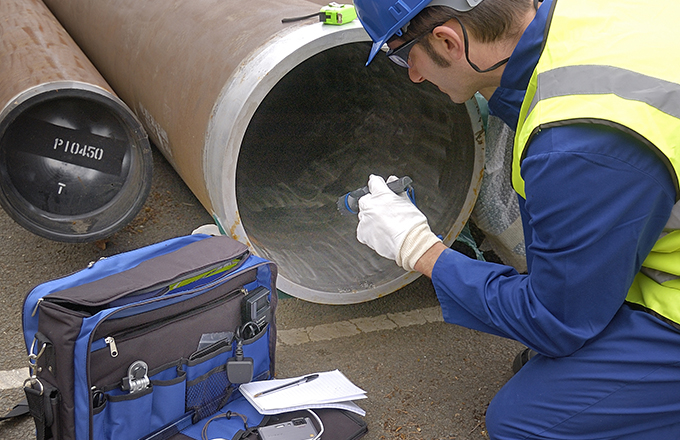Cutting-edge Methods to Fillet Weld Examination and Screening: Enhancing Weld High Quality and Conformity Criteria
In the world of welding, the quality and integrity of fillet welds play an important duty in making certain the architectural sturdiness and reliability of various industrial elements. With the continuous drive for improved effectiveness and compliance with strict standards, the expedition of cutting-edge approaches to fillet weld evaluation and screening has ended up being imperative. As industries evolve, the traditional techniques may no more be adequate in satisfying the demands of modern-day welding applications. By accepting advanced technologies and techniques, a new horizon of opportunities emerges in the world of weld high quality assessment and adherence to conformity standards.
Advanced Non-Destructive Testing Techniques
Making use of cutting edge modern technologies, advanced non-destructive testing approaches play an important duty in ensuring the stability and top quality of fillet welds. These techniques, such as phased variety ultrasonic screening (PAUT) and magnetic particle screening (MPT), deal detailed insights right into the weld's inner structure without triggering any kind of damage to the material. PAUT, for example, makes use of multiple ultrasonic aspects to evaluate the weld from numerous angles, offering a detailed visualization of potential problems like absence of blend or splits.
Similarly, MPT works in identifying surface-breaking defects by applying a magnetic area and iron fragments to the weld area. This method is especially beneficial for determining stoppages that might compromise the weld's strength. By employing these sophisticated non-destructive testing strategies, weld assessors can properly assess the quality of fillet welds, guaranteeing conformity with sector criteria and laws. The capability to find problems early on not only enhances weld high quality however likewise stops pricey rework or failings in architectural honesty, underscoring the significance of these innovative testing approaches in welding evaluations.
Robotics and Automation in Inspection
The assimilation of robotics and automation has reinvented the inspection process for fillet welds, boosting effectiveness and accuracy in quality assessment. Robotics use exact control and repeatability in checking welds, making certain reputable and consistent outcomes. Automated systems can be configured to adhere to certain inspection paths, making certain extensive coverage of welds and decreasing the threat of human error.
Robotic examination systems equipped with sophisticated sensing units can spot and determine weld features with high accuracy, giving detailed data for analysis. These systems can determine issues such as cracks, lack of combination, and porosity, making it possible for prompt restorative activities to be taken. In addition, robotics and automation allow for real-time data collection and analysis, supplying prompt responses to operators and assisting in fast decision-making procedures.
Furthermore, using robotics and automation in fillet weld assessment boosts total productivity by decreasing assessment times and boosting examination throughput. By simplifying the inspection process, manufacturers can guarantee weld quality and compliance requirements are satisfied efficiently, ultimately resulting in cost financial savings and improved item high quality.
Making Use Of Expert System for Evaluation
Man-made intelligence plays a pivotal role in boosting the performance and precision of analysis in fillet weld examination processes. AI algorithms can swiftly refine substantial amounts of data from weld evaluations, detecting flaws or variances that might be challenging to recognize with the nude eye - Welding Inspection Racine.
Additionally, AI systems can pick up from past examination data, continuously improving their capability to recognize potential problems and inconsistencies in fillet welds. This adaptive learning capability improves the general quality assurance procedure, reducing the likelihood of human mistake and guaranteeing that welds fulfill the required standards. By integrating expert system right into fillet weld analysis, markets can attain greater levels of efficiency, uniformity, and compliance in their examination techniques.
Portable Equipment for On-Site Inspection
 Enhancing field inspection effectiveness, the fostering of mobile devices revolutionizes on-site assessment processes for fillet welds. These click this tools provide versatility and comfort, enabling examiners to carry out detailed examinations in various locations, including challenging or remote environments. Mobile devices such as ultrasonic screening tools, magnetic fragment examination tools, and electronic radiography systems give real-time information and high-resolution imaging capacities, making it possible for fast decision-making and instant comments on weld high quality.
Enhancing field inspection effectiveness, the fostering of mobile devices revolutionizes on-site assessment processes for fillet welds. These click this tools provide versatility and comfort, enabling examiners to carry out detailed examinations in various locations, including challenging or remote environments. Mobile devices such as ultrasonic screening tools, magnetic fragment examination tools, and electronic radiography systems give real-time information and high-resolution imaging capacities, making it possible for fast decision-making and instant comments on weld high quality.One considerable advantage of portable devices is their capacity to enhance anonymous assessment treatments, minimizing downtime and improving general efficiency. Examiners can easily transfer these tools to different work websites, getting rid of the need for transferring heavy equipment or elements to off-site facilities. Furthermore, the mobility of these tools advertises cost-effectiveness by reducing transportation expenses and increasing assessment timelines.
Additionally, using portable devices for on-site evaluation promotes aggressive top quality control steps, as inspectors can promptly recognize and attend to any type of potential welding issues or disparities. By integrating these innovative modern technologies into on-site inspection techniques, welding experts can make certain compliance with sector criteria and enhance weld top quality, eventually resulting in boosted structural honesty and safety in numerous welding applications.
Combination of Data Management Systems
Having actually enhanced on-site assessment processes via the usage of mobile tools, the following stage entails the seamless assimilation of data administration systems to further improve efficiency and data evaluation capabilities in fillet weld evaluation and screening. Welding Inspection Racine. By integrating data monitoring systems right into the inspection process, companies can streamline data collection, storage, and analysis. This combination enables real-time monitoring of weld high quality, prompt recognition of problems, and timely decision-making to rectify any concerns that might emerge throughout the inspection process
The assimilation of data monitoring systems allows smooth communication in between different stakeholders included in the inspection procedure, cultivating partnership and boosting overall high quality control actions. Eventually, the assimilation of data administration systems click this site offers to raise the criteria of fillet weld evaluation and screening, making certain compliance with market laws and enhancing weld top quality.
Verdict
In conclusion, ingenious strategies to fillet weld evaluation and screening have significantly improved weld high quality and conformity standards. Advanced non-destructive testing techniques, robotics, automation, expert system, mobile devices, and data management systems have reinvented the means weld inspections are carried out. By using these modern technologies, sectors can ensure that welds satisfy the called for top quality criteria and regulations, ultimately enhancing general effectiveness and security in welding processes.

By utilizing these innovative non-destructive screening methods, weld examiners can precisely examine the high quality of fillet welds, making sure conformity with sector criteria and guidelines. Portable tools such as ultrasonic testing tools, magnetic fragment examination tools, and electronic radiography systems provide real-time data and high-resolution imaging capabilities, enabling quick decision-making and immediate feedback on weld high quality.
Having enhanced on-site assessment procedures through the application of mobile tools, the following phase entails the seamless integration of information administration systems to even more boost effectiveness and data evaluation abilities in fillet weld inspection and screening (Welding Inspection Racine). Eventually, the integration of information management systems offers to elevate the criteria of fillet weld assessment and testing, making sure compliance with sector policies and boosting weld high quality
 In verdict, ingenious methods to fillet weld inspection and screening have significantly improved weld quality and conformity standards.
In verdict, ingenious methods to fillet weld inspection and screening have significantly improved weld quality and conformity standards.